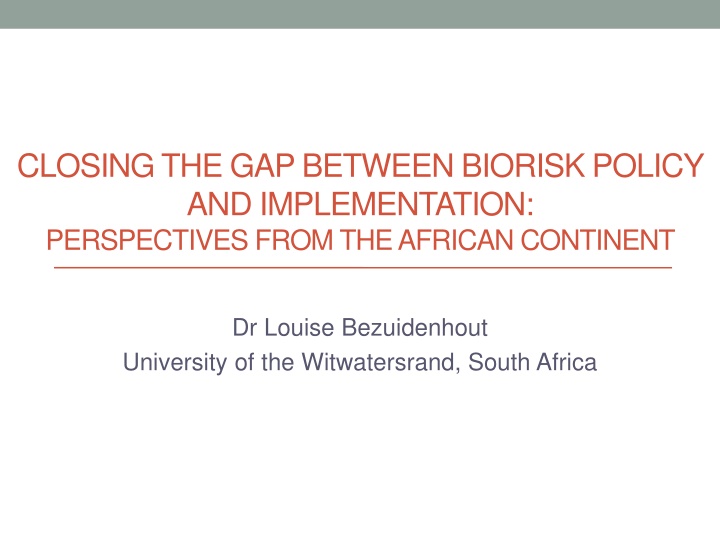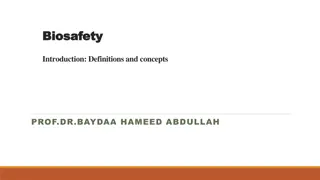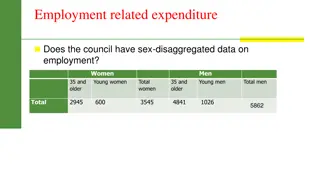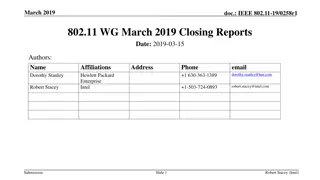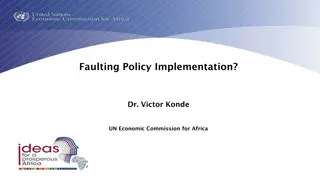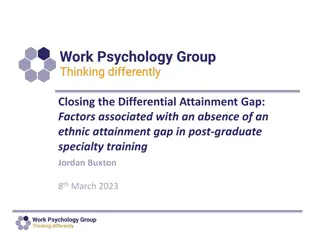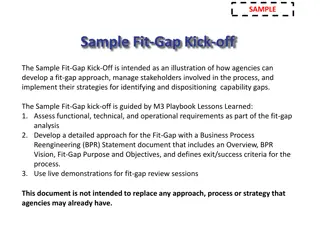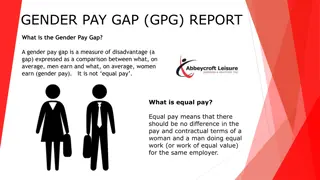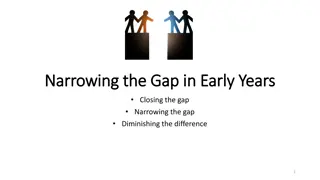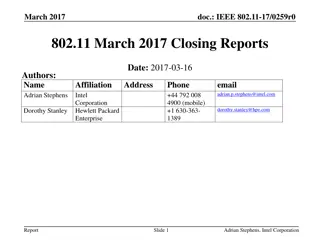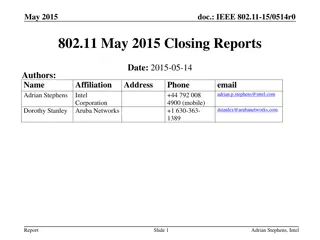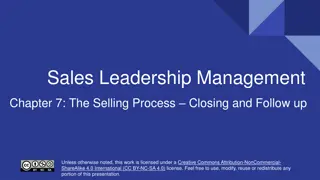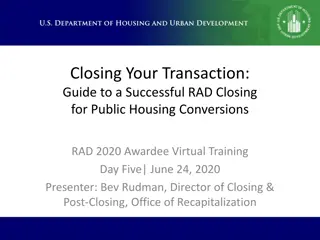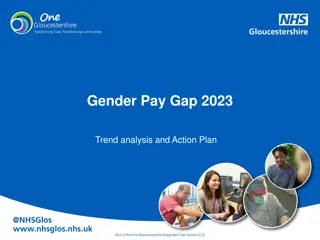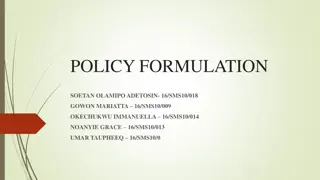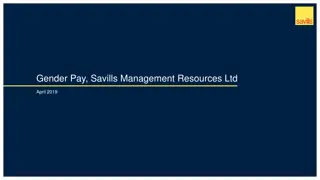Closing the Gap Between Biorisk Policy and Implementation in Africa
This presentation by Dr. Louise Bezuidenhout from the University of the Witwatersrand, South Africa, discusses the challenges and current developments in biosafety and biosecurity regulation in Africa. It outlines the research, funding, and policy landscape, focusing on the gap between policy formulation and implementation. The case study of South Africa highlights strengths and weaknesses in existing legislation and practices related to biosafety and biosecurity.
Download Presentation

Please find below an Image/Link to download the presentation.
The content on the website is provided AS IS for your information and personal use only. It may not be sold, licensed, or shared on other websites without obtaining consent from the author.If you encounter any issues during the download, it is possible that the publisher has removed the file from their server.
You are allowed to download the files provided on this website for personal or commercial use, subject to the condition that they are used lawfully. All files are the property of their respective owners.
The content on the website is provided AS IS for your information and personal use only. It may not be sold, licensed, or shared on other websites without obtaining consent from the author.
E N D
Presentation Transcript
CLOSING THE GAP BETWEEN BIORISKPOLICY AND IMPLEMENTATION: PERSPECTIVES FROM THE AFRICAN CONTINENT Dr Louise Bezuidenhout University of the Witwatersrand, South Africa
Outline Research in Africa Biosafety and biosecurity regulation and oversight Current developments the ASSAf survey Implementing policies in low- resourced research environments key challenges http://www.simpl.co/challenges/29-the-planet- earth-institute-africa-science-challenge
R&D on the African Continent Adams, King, Hook (2010) Global Research Report: Africa
Funding for Research http://www.oecd.org/innovation/inno/research anddevelopmentstatisticsrds.htm Adams, King, Hook (2010) Global Research Report: Africa
Biosafety and Biosecurity Policy Biosafety legislation Growing number of countries have biosafety legislation Often relating to agriculture Regional developments African Model Law on Biosafety (1999) GM focus African Association for Biological Safety International commitments Kampala Compact Nairobi Announcement recommended a model law on biosecurity Much remains on the level of institutional activities and funding requirements
A Better Case Scenario: South Africa The State of Biosafety and Biosecurity in South Africa (Academy of Science of South Africa, 2015) 1. Overview of existing legislation, regulations and practices relating to biosafety and biosecurity Identify strengths, weaknesses and gaps in laws and implementation 2. Evaluation of existing measures and capacity to detect, control and prevent the natural, accidental and spread of infectious agents 3. Critical overview of current practice in relation to the implementation of biosafety and biosecurity measures and the application of ethics in South African laboratories Extent to which lab practices address safety and security concerns Applicability and balance of relevant ethical principles Full report at: http://www.assaf.org.za/Final%20WEB%20K- 12423%20ASSAF%20Biosafety%20and%20Biosecurity%20Report_D evV11LR.pdf
Key Outcomes Findings SA legislative framework is robust and comprehensive but suffers from limitations including coherence in the categorization of pathogens, lack of harmonization of guidelines and infrastructure and capacity challenges for implementation Development of a database of all functional life science facilities in the country is an important tool for future discussions Survey of biosafety, biosecurity and dual-use awareness amongst scientists indicates low penetrance of awareness of regulations or ethics Purposively-sampled interviews with experts in the field of infectious disease outbreaks in SA highlighted the complexity of systems required to manage outbreaks and lack of trained human resources
Key Recommendations Recommendations Improve capacity to detect and respond to infectious disease outbreaks Need single, locally relevant list of infectious agents that is regularly updated Need to rationalize complex systems and improve communication between sectors Education and awareness raising Significant gaps in training of scientists pertaining to ethics, biosafety, biosecurity and dual-use Gaps in relation to implementation of existing rules and regulations including SOPs, tests of competence and maintenance of lab equipment Ethics review Need for review of research not involving human subjects Scientific openness and transparency In relation to collaboration, funding, publication and research priorities
Responsible Conduct in the Lab (1) Chronic lack of awareness of biosafety, biosecurity and dual-use issues amongst science population Need to improve biorisk training in tertiary education Lack of education Lack of relevant legislation Lack of accessible legislation Legslative confusion need to clarify terminology and focus biosafety , biosecurity and ethics all unclear International funding can have competing requirements http://archive.sciencewatch.com/ ana/fea/10mayjunFea/
Responsible Conduct in the Lab (2) http://www.shutterstock.com Unrealistic expectations leading to ethical erosion, confusion, frustration or non-compliance (Bezuidenhout 2014, 2015) Provision of funds to implement change
Responsible Conduct in the Lab (3) Research vs diagnostic laboratories Differing levels of biorisk awareness Mentorship and support for younger scientists Young scientists felt unsupported Lack of mentors Lack of biorisk champions Contextualise codes of conduct discussions Need to make discussions locally relevant to ensure buy-in
Responsible Conduct in the Lab (4) Need more communication between policy makers and life science community Need structures to consider misuse of research at all stages Indicates need for biorisk assessment processes and better protection of whistleblowers.
Strengthening Biorisk Management in Africa Not just about policy development Need to capitalize on expertise within science community More communication between policy makers and scientists Rationalization of institutional, national, international and funding requirements Need more comprehensive reviews Critical discussion on how best to achieve regulatory and ethical targets in low-resourced environments More awareness of difficulties of transposing regulations and ethical concerns across borders
Thank You Please feel free to contact me at louise.bezuidenhout@wits.ac.za https://upload.wikimedia.org/wikipedia/commons/thumb/8/86/Africa
